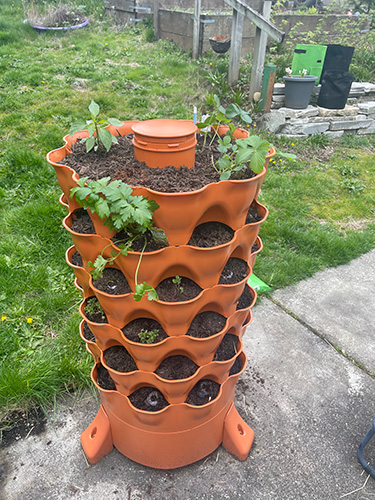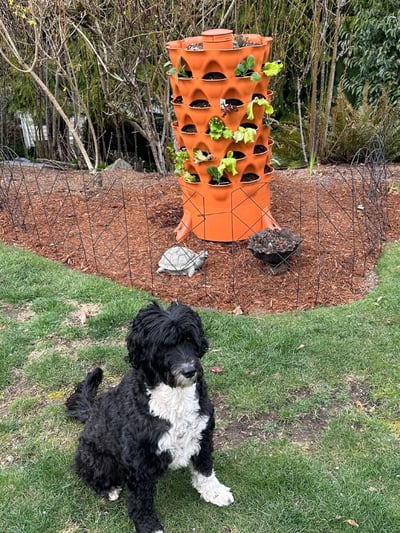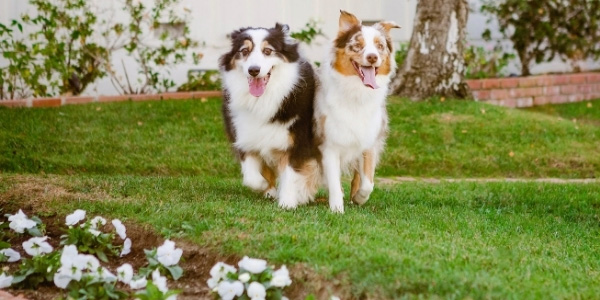 Spring is such an amazing time of year — what once appeared dead now has new life. Individuals are drawn to the outdoors to nurture and help nature flourish.
Spring is such an amazing time of year — what once appeared dead now has new life. Individuals are drawn to the outdoors to nurture and help nature flourish.
While we are helping one aspect of life thrive, we risk accidentally harming our dogs or cats.
There are many things that pet owners should be aware of when they are rejuvenating and maintaining their yards to keep their pets safe.
I have a black thumb. I can hardly keep a cactus alive! I am so envious of those who can get any type of plant or flower to thrive or those with lawns as green and manicured as a golf course. To make this happen, they put in a lot of work!
There are special soil additives, trimming things just right, or using pesticides to keep the creepy crawlies away. And while these are highly beneficial to plants or grass, they may not be so for our pets. The remainder of this article will discuss common yard care products, tools, and features that are dangerous for pets.
While by no means am I saying you can’t use certain things — because I would never deprive someone of a beautiful yard — I just want you to use extra caution if there are pets around. And if you want to keep cats and dogs out of your garden, check out what our team is using.
What Fertilizers Are Toxic to Pets?
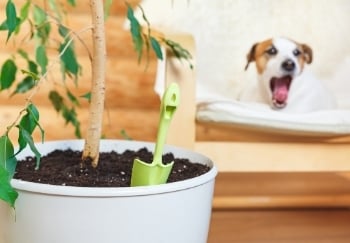
Let’s talk fertilizers! I admit I wouldn’t know what type to use for plants versus flowers. But what I can tell you is what types of fertilizer ingredients can potentially harm your pet.
- Nitrogen
- Phosphorus
- Potassium
These three ingredients are present in most fertilizers and are toxic to pets. There are other ingredients, as well as specific fertilizer types, that are also toxic and covered further below.
The following is a general guideline of potential symptoms, which depend on how much fertilizer your pet ingests:
- Vomiting
- Diarrhea
- Lethargy
- Excessive drooling
- Intestinal blockage — your pet may vomit continually after eating, or you may notice that they are not producing any poop
- Constipation
- Stomach pain
- Weakness in the back legs
- Stiff muscles
Some fertilizers, such as those listed below, have potentially more severe risks to our pets.
Bone Meal Fertilizers
While being organic is great, it doesn’t mean safe. Since it contains bones, many dogs find it to be highly desirable. It can cause your pet to have vomiting and diarrhea, as well as cause pancreatitis. But even worse, if large amounts are consumed (depending on the size of your dog), bone meal can obstruct the gastrointestinal tract because it can become solidified in a cement-like object in the stomach. Sadly, this can result in your pet possibly needing surgery.
Blood Meal Fertilizers
Blood meal fertilizer contains 12% nitrogen. Some brands also contain iron, and therefore iron toxicity can occur if pets ingest it. If your pet ingests blood meal, it can cause vomiting and diarrhea. It has also been found to cause severe pancreatitis.
Rose Fertilizers
While roses are beautiful, they require special care. Fertilizer for roses typically contains disulfoton, which can be fatal. A dog weighing 55 lbs. can be killed with just one teaspoon of 1% disulfoton.
Other Fertilizers
Some fertilizers contain Organophosphates. This particular ingredient can result in severe symptoms such as salivation, tearing, urination, uncontrolled pooping, seizures, difficulty breathing, etc. In certain cases, it can be fatal. Additionally, some fertilizers contain herbicides, pesticides, and fungicides. These can cause pets to drool, vomit and have diarrhea.
If you suspect your pet has ingested fertilizer, contact your pet’s veterinarian immediately or a pet poison helpline. Be prepared to answer questions with regard to the fertilizer that your pet may have consumed. Some things you need to know about the fertilizer:
- The ingredient list
- The ratio of nitrogen, phosphorus, and potassium
- The form that the fertilizer came in — liquid, powder, or granules
- Know if there are any herbicides, pesticides, or fungicides in the ingredient
- Know if there are other additives such as lime, iron, copper, etc.
Questions? If you're concerned about your dog or cat and would like to chat with a veterinarian, Click here
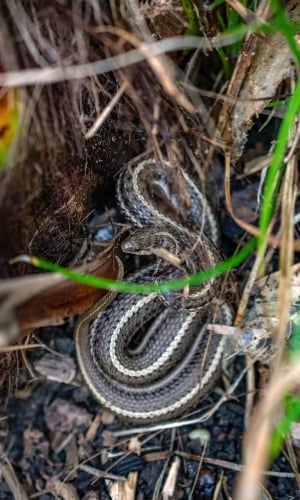 Snakes in Your Yard
Snakes in Your Yard
Now that your plants have been nourished with the appropriate fertilizer, it is time for the beautification of plants and bushes. Neither you nor your pet needs to risk getting bitten by snakes hiding in leaves or under low branches. So, it's important to rake out old leaves around bushes and plants, as well as trim the base of some plants or bushes that lay right on the ground.
While this isn’t essential in all areas, I highly recommend it in areas where snakes, especially poisonous snakes, live. Additionally, snakes like rock piles. Try to avoid rock features in landscaping so you aren’t giving snakes places to hide in your yard.
If you live in an area with poisonous snakes, teach your dog snake avoidance. Training your dog to avoid snakes can save their life.
Rodenticides
Speaking of snakes, they love rodents! Keeping the rodent population under control is essential not only for the control of snakes but also preventing issues in your home. This, however, brings up another potential danger to pets — rodenticides.
Rodenticides are a common toxin for pets since they are commonly used and are tasty to most pets. Additionally, pets can be poisoned by eating dead mice or rats that have consumed the poison. It is critical for households with pets and children to use the appropriate bait stations. These stations are tiered based on their level of tamper resistance.
Tiers I – II are considered dog-resistant. This DOES NOT mean “dog-proof.” Therefore you must still use caution when using rodenticides around pets. Be sure to read all labels and instructions very carefully.
Essentially rodenticides work by causing blood clotting issues or kidney failure. There are four general categories of rodenticides.
- Long-Acting Anticoagulants: Most widely-used and well-known. It prevents the body from clotting normally, so internal bleeding occurs. Usually takes two to five days for the poison to take effect.
- Cholecalciferol (Vitamin D3): One of the most dangerous. It causes kidney failure by increasing blood levels of calcium. Only small amounts are needed to cause a problem, and there is no antidote (cure or treatment).
- Bromethalin: Not commonly used. It causes brain swelling, and there is no antidote. Pets who ingest it are seen walking abnormally as if drunk, having tremors and seizures.
- Phosphides: This particular poison is more commonly used to kill gophers and moles. It only requires a small amount of this poison to cause significant problems. It causes bloat, profuse vomiting, stomach pain, and potential complications with the heart and lungs. The symptoms are due to the phosphine gas that is produced in the stomach. Humans can be poisoned due to inhaling the phosphine gas in their pet’s vomit.
- Tres Pasitos: This is illegal in the United States due to its extreme toxicity to children and pets. Often illegally imported and stored in unlabeled plastic bags, Tres Pasitos' active ingredient is aldicarb — which the EPA advises should never be used in your home.
Remember to ALWAYS store rodenticides and other poisons out of the reach of children and animals. If you suspect your pet has consumed ANY rodenticide, contact a veterinarian immediately.
Possible Signs of Rodenticide Poisoning in Dogs or Cats
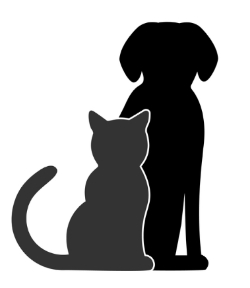
- Bruising or petechiation (small, pinpoint red dots — most typically seen on the gums, inner ear, or hairless part of the belly)
- Pale gums
- Seizures
- Vomiting (possibly with blood)
- Coughing (possibly with blood)
- Lethargy or weakness
- Breathing problems (e.g., difficulty breathing, rapid breathing)
- Rapid heart rate/pulse
- Uncontrolled bleeding (often seen as nosebleeds or easy bruising)
- Increase in thirst and urination
- Blood or dark discoloration of the urine
- Change in color of their bowel movements –– can be dark black and "tarry," blood red, or even bright green or blue (the green or blue color comes from the baits themselves)
Consider using pet-safer, non-poison options, like electric or catch-and-release traps. Learn more here about rodenticide poisoning in pets.
Questions? If you're concerned about your dog or cat and would like to chat with a veterinarian, Click here
Is Mulch Dangerous for Pets?
To me, mulch makes landscapes look fresh and complete. There is something about laying mulch that makes a gardener feel like they have completed the beautification process. Many of you may be wondering why I mention mulch as a hazard to pets. While it isn’t as scary as rodenticides, pet owners need to be aware of the threat it poses to pets.
While most mulch is safe, there are some things to keep in mind when using it in your yard. Dogs, especially puppies, love to chew. And they really love to chew and swallow things when we want to get it away from them! Excessive consumption of mulch, since it can be made of shredded bark, can lead to intestinal blockages. It is much like the danger sticks pose to dogs.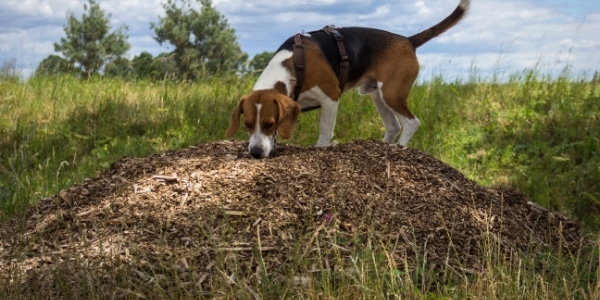
Cocoa Bean Mulch
There is a specific type of mulch you must use caution with. It is called Cocoa Bean Mulch. While it sounds yummy and smells amazing when warmed in the sun, the cocoa bean shells contain theobromine and caffeine. Theobromine is what makes chocolate toxic for dogs. Dogs, just like people, are drawn to the aroma of this mulch, and they tend to want to eat it. The risk to pets is based on a few different aspects:
- The size of the dog
- The amount of mulch consumed
- The levels of theobromine that the mulch contains
- The biggest risk is to puppies and small-breed dogs
In addition to the above concerns, this type of mulch often contains pesticide residue as well as mycotoxin-producing molds. If your pet consumes these molds, it can result in severe neurologic signs, tremors, and seizures.
On average, symptoms of toxicity usually start within 6–12 hours after eating mulch. The following are some of the symptoms to look for:
- Vomiting
- Diarrhea
- Stomach pain
- Hyperactivity
- Increased heart rate
- Increased respiratory rate
- Muscle tremors
- Seizures
- Depending on the amount, death is possible
The best thing to do is avoid using this type of mulch if you have pets. There are pet-safe options such as pine, cedar, or hemlock mulches. Now, while these may be safer options, there can still pose a problem for some pets. Pets can still choke on these types of mulch, and some pets have been known to have allergic reactions to mulch.
As with any potential toxin, I always recommend contacting a veterinarian immediately. It is also important to keep a pet poison helpline number available. This number should be displayed, big and bold, in an easy-to-view location. Click here for Pet Poison Helpline and ASPCA Animal Poison Control contact information.
Slug and Bug Baits, Insecticides, and Herbicides
Your plants and shrubs now look amazing, and of course, you want to keep them that way. That requires keeping the creepy crawlies and such away! The positive thing is that most pesticides and insecticides usually are not a huge concern and can just be a basic irritant. BUT some can contain organophosphates, which, as we learned earlier in fertilizers, can be life-threatening if they are consumed in significant quantities.
In some areas of the US, slug and snail baits are used. They come in several forms, such as pellets, granules, powders, or liquids. These contain a toxic ingredient called metaldehyde. When pets ingest these baits, within 1 to 2 hours, you will notice the following symptoms:
- Salivation
- Restlessness
- Vomiting
- Poor balance
- As time progresses, seizures and tremors occur
Immediate treatment at a veterinary hospital is critical. If treatment is provided quickly and aggressively, the prognosis is favorable.
Looking for a pet-safer way to rid your garden of slugs or snails? Read what you can use instead of slug or snail bait here.
Pyrethrin and Pyrethroid Toxicity in Cats
Chrysanthemums are the lovely flower that we derive pyrethrin insecticides from. The synthetic version is referred to as pyrethroid. These are present in outdoor yard and garden insecticides as well as in-home products. They can be sprays, liquids, or foggers. Additionally, some fertilizers contain them. Toxic effects are dependent on the animal species involved as well as the concentrations used. While their use is generally safe for dogs unless they are exposed to high concentrations, cats are VERY sensitive to pyrethrin and pyrethroids. Cats are unable to quickly break down pyrethrin/pyrethroids, so it only takes a small amount to cause problems.
The chrysanthemum plant itself is toxic to dogs and VERY toxic to cats. I would recommend not using it in your landscapes.
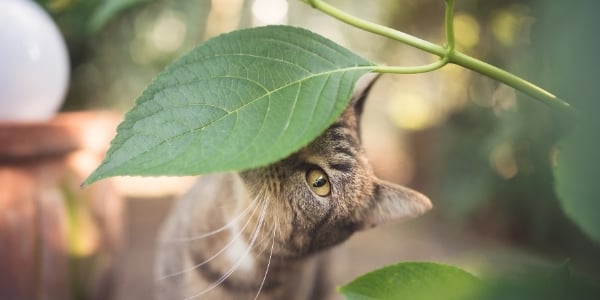
The typical signs of pyrethrin poisoning, which can range from 15 minutes to several hours, can include any or all of the following:
- Drooling
- Vomiting
- Gagging
- Restlessness
- Tremors
- If exposure is severe – seizures, coma, and death are possible
- Some dogs can have skin reactions, for example, itchiness with crying
Dogs and cats have similar reactions to pyrethrin and pyrethroids. Cats, however, have more severe reactions because they lack the liver enzymes needed to break down pyrethrin. Cats will usually have tremors and shaking as the initial signs. SEEK VETERINARY CARE IMMEDIATELY if you suspect your cat has been exposed since this can be life-threatening to your cat.
I recommend avoiding products that contain this insecticide if you have cats. For dog owners, be sure to read labels very carefully and store all products appropriately.
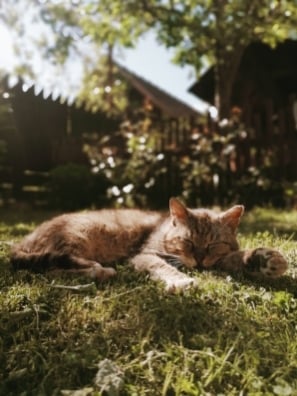
Fire Ants & Pets
If you have ever been bitten by a fire ant, you know true pain! Fire ants create these huge sandy mounds that are ever so inviting to curious pets. Sadly, when curiosity gets the best of our pets, they can be stung by these horrible little creepy crawlies. They typically like to sting areas with little to no fur. This means that pets are often stung on their ears, muzzles, and their underside. Getting rid of fire ants is the safest option for humans and pets.
When used appropriately, fire ant bait is of low toxicity to pets. But it is critical to read all labels and use only as directed. Be sure to remove all pets from the area that is being treated and store the bait in an area that pets cannot get to.
Using Weed Killers if You Have Pets
They often say one man’s weeds are another’s flowers. For those that view weeds as the enemy, there are weed killers. The good news is that most of these chemicals are selective for plants and have low toxicity for animals. This is especially true when applied at the proper rates, and you don't allow your pet in the treated area for the first 72 hours following application.
However, be sure to read all package labels to see if other precautions with a pet are needed. You want to avoid your pet walking, playing, rolling, and licking the treated area during the initial period so that the chemicals can be absorbed into the ground. Typically the residue potential is low for the majority of these chemicals. Issues arise when pets are exposed to excessive quantities of the chemical.
I cannot stress this enough — proper handling and storage of all chemicals is critical to prevent harm to pets.
Important things to be aware of about weed chemicals
A commonly used lawn chemical is glyphosate. It was invented in 1974 and is widely used in commercial and industrial products worldwide.
There are many concerns about this chemical's ecological and human health impact. Therefore, it is the subject of many studies.
While the U.S. Environmental Protection Agency (EPA) and The European Food Safety Authority agree that there is no evidence that glyphosates cause cancer in humans, other organizations say otherwise.
In 2015, The World Health Organization’s (WHO) International Agency for Research on Cancer stated that the chemical is “probably carcinogenic to humans.” Studies at the University of Washington in 2019 indicated that the risk of non-Hodgkin's lymphoma was increased by using glyphosate.
Another common lawn chemical, 2,4-D, has also been linked to an increased risk of cancer (non-Hodgkin’s lymphoma) and other health issues in some studies. However, other studies have found no evidence of a link.
What does this mean for dogs?
Since the lifespan of dogs is increasing, the rate of cancer is as well. Cancer develops in about 50% of dogs over the age of ten.
However, studies are finding that the development of cancer occurs prior to the average median age expected. There are studies indicating that these increases may have to do with exposure to environmental chemicals, such as glyphosate and 2,4-D.
What should you do about weed control?
For the safety of you and your pets, err on the side of caution with regard to lawn chemicals.
Avoid the use of lawn chemicals or only use sparingly while taking all precautions (wear gloves and mask, avoid contact until dry, and store properly). On walks, don’t allow your pet to walk on those bright and beautifully manicured lawns since they likely are treated with chemicals.
If safe fruit or veggies are part of the menu for you and your pet, be sure to wash them with a veggie wash and peel them before eating.
There are alternatives to chemicals for killing weeds. Some suggestions from experts at North Carolina State University include:
- Get down and dirty: Remove weeds by hand. You can pull them with your bare hand or try a hand tool.
- Burning weeds: While best used for driveways and sidewalks, you can use heat to kill seedling broadleaf weeds. Note: Use caution in the dry season to avoid starting a fire, and never operate around pets.
- Steam or hot-foam weeding: A foaming agent used combined with pressurized steam or hot water works well to kill weeds. This is useful when fire codes ban burning or when weeds are present near flammable material. Note: Severe burns can be caused by the steam or foam, so take precautions and don't operate near pets.
Water Features & Pet Safety
Water features have so many benefits to a yard. They add a beautiful accent to the landscape, they are calming, and they can attract some amazing wildlife. But as with everything else that has been mentioned, even water has its hazards.
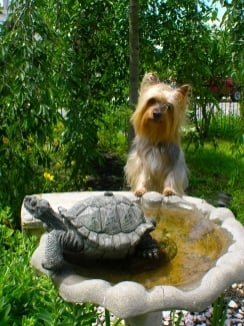 “Still or sitting” water, such as that in a birdbath or pond, can be a breeding ground for some unwanted problems. Mosquitoes love still water to lay eggs in. These little ‘buggers’ are not only a nuisance as they fly around and bite you, but they can transmit heartworm disease to your pet. So, if possible, change the birdbath daily or find a way to agitate the water slightly.
“Still or sitting” water, such as that in a birdbath or pond, can be a breeding ground for some unwanted problems. Mosquitoes love still water to lay eggs in. These little ‘buggers’ are not only a nuisance as they fly around and bite you, but they can transmit heartworm disease to your pet. So, if possible, change the birdbath daily or find a way to agitate the water slightly.
In addition to mosquitoes, still water can grow toxic algae. These toxic algae are called blue-green algae or cyanobacteria. When these algae bloom, they contain toxins that can affect the liver and nervous system. To prevent this from occurring, some gardeners use chlorine tablets. As one can imagine, this can cause potential harm to pets as well. Therefore, try to find other forms of treatment for algae, such as UV light treatment.
One last thing to be aware of with water features in your yard is the potential for bacteria, viruses, and parasites. Some common ones to know about are Giardia, E. coli, and Leptospira. Be sure that you keep your pet from drinking any water from outdoor water features. Unfortunately, if your pet is infected with any of these, veterinary attention for treatment will be important. If your pet does become infected and doesn’t receive veterinary care, organ damage and death can occur.
Keeping Your Pet Safe Around Yard Tools
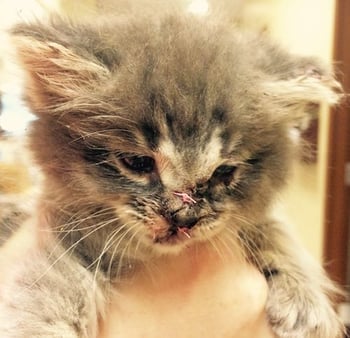
Yard tools save us from a lot of extra backbreaking work. But as with any tool, you must take some safety measures. I always recommend any time you are using some type of yard tool, whether electric or not, keep your pet indoors. Pets are curious creatures and can easily be injured by trying to be a part of what you are doing.
Cats and small dogs can easily hide in bushes you are trimming and get cut by trimmers, debris can go flying from mowers or weed eaters, causing injury to their body, and it’s easy for them to step on the tine of a rake or open clippers causing a cut to their paw. The list can go on and on!
Make life easier and less stressful for you — keep pets away from yard tools when in use.
The outdoors is meant to be enjoyed by all. Just be sure you’re aware of the potential risks and take the necessary precautions to protect your beloved pet.
Keeping Pets and Critters Out of Your Garden
We'll soon be writing a whole article about this, but some of our garden-loving team members are testing out some new tricks and products for saving their gardens from squirrels, outdoor cats, and their own dogs, who love to trample, nibble on strawberries, and pee in the garden.
The Garden Tower is something that is perfect for any yard or patio. You can plant up to 50 plants, and with a little fencing, you can easily keep your dogs out, and the other garden visitors are not as tempted because of its vertical design. And the additional amazing part is this tower has a center column for vermicomposting! Add some compost materials and some red wigglers, and you have a composting, self-sustaining garden ecosystem. We'll be posting more tips as the garden season progresses.
Happy planting!



